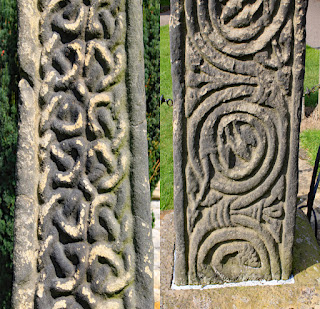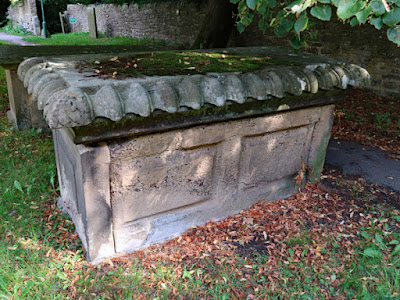When I first visited Eyam with the Sheffield U3A Geology Group, back in April 2017, I very briefly popped into St. Lawrence’s churchyard to take a couple of photos of the Anglo-Saxon cross but, as with the rest of the photos that I took on that day, I have misplaced these.
After completing my brief survey of the exterior of the church, I went to have another closer look at the gritstone cross, which is dated by various sources to either to the C8 or C9 and has both Scheduled Ancient Monument and Grade I Listed status.
The cross is said to be the only one of its type in the Midlands that retains its cross-head, although a section of the shaft is missing, with the rich decoration and interlacing scroll-work on the west face considered to be typically Mercian in design.
On my list of buildings for the British Listed Listed Buildings Photo Challenge for Eyam, there were two Grade II Listed table tombs and I next went to find these. The first of these, with an uninscribed slab, is dated to the mid C17 and is thought possibly to be the tomb of one of the victims of the Eyam plague of 1665 and 1666.
It is made of gritstone and has fluted pilasters to the corners and on both of the south and north sides. The panels are also decorated, with the south side having thistle shaped vases with loop handles containing different types of flowers - including tulips that were very rare in England at the time - and two urns on the south side. There are semi-circular headed niches to the east and west ends, with that to the east having a skull and crossbones in relief and a winged angel head and hour glass to the west.
 |
| A skull and crossbones |
The second tomb on my list is described by Historic England as “Table tomb. Early C18. Stone. Base with raised and fielded panelled sides and moulded band. Slab over with gadrooned edges and acanthus leaves to corners. Inscription on top too worn to be legible.“
A third Grade II Listed table tomb, which already had a photograph on the British Listed Buildings website, was that of Catherine Mompesson - the wife of the rector of Eyam, William Mompesson, who stopped the plague of 1666 from spreading to other areas. Historic England cites two Latin inscriptions: 'Mors Mihi Lucrum' and 'Catherina Uxor Guliemus Mompesson Huius Ecclesiae Rects Filia Randolphi Carr Nuper de Cocken in Comitati Durelmensis Armigeri Sepulta Vicessimo Quinto die Mansis Augti Ano Dni 1666'.
In the church guidebook, the two inscriptions are translated as: “Death is my Reward and “Catherine Wife of William Mompesson The Church Rector Daughter of Randolph Carr Lately Of Cocken in Durham. Buried Twenty Fifth Day Of August AD 1966.”
On the west side of the tomb, there is an hour glass set within a winged plaque, below which there is yet another Latin inscription: "CAVE(TE) NESCITIS HORAM”, which translates as “Beware. You do not know the hour.”
The unlisted war memorial is described by the Imperial War Museum as being made of limestone and, although I didn’t look at the memorial closely, the wheel cross is decorated with a fleurs-de-lys, a crusader's sword, a pelican feeding its young carved and a carved lotus flower and foliation. The names of the fallen in WWI and WWII are inscribed on four plaques of red Balmoral granite from Finland, which are attached to the lower part of the shaft.
Attached to the south chantry wall are a pair of C13 gravestones incised with crosses, along with crocketted finials that are presumably from the C15 and were retained when the church was restored during the C19. After having a very quick look at a few other interesting headstones dating back to the C18, I then went to look at the interior of the church.











No comments:
Post a Comment